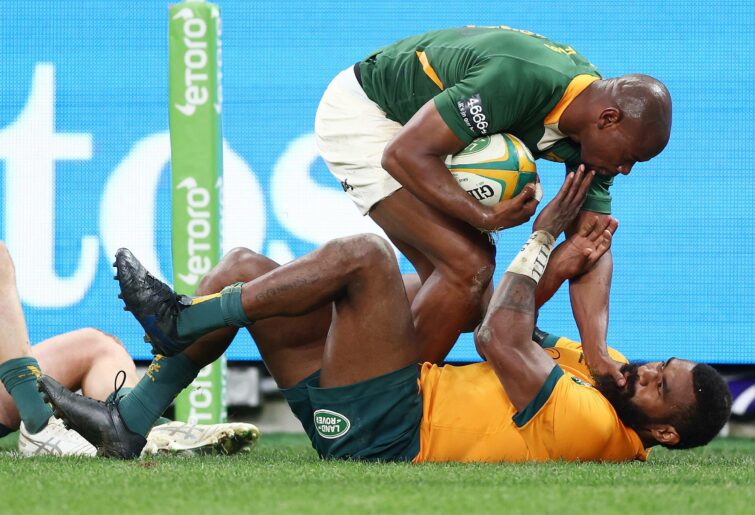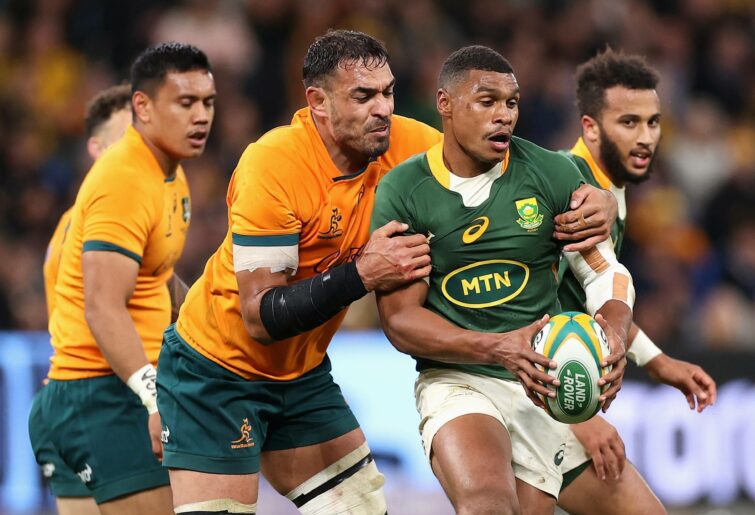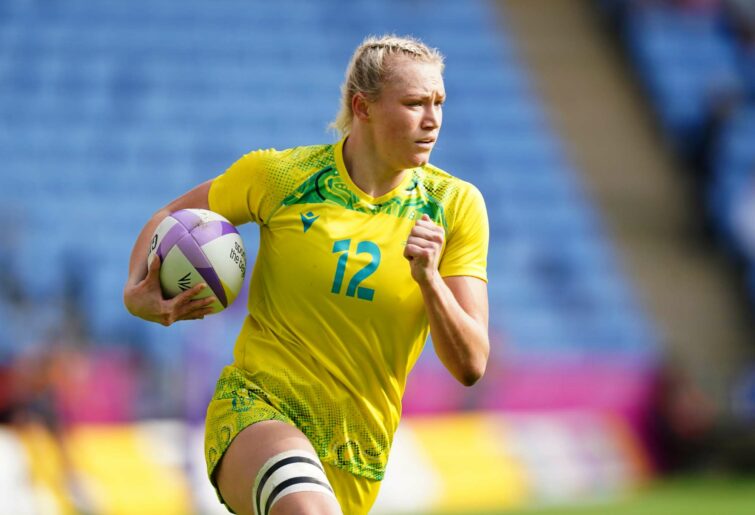That they did; the All Blacks annihilating the Pumas 53-3 in Hamilton, and the Springboks dominating all areas against the Wallabies, comfortable winners by 24-8.
The upshot is that only one point separates all four nations, each with a home and an away match to come. It really is “anybody’s match from here”.
With a bonus point and a healthy points differential, New Zealand has its nose in front. But it is barely a nose. The way things have been this year, nobody is banking two wins against Australia just yet.
That wasn’t the winning of the Rugby Championship NZ Rugby CEO Mark Robinson was enthusiastically clapping on Saturday night, but the fact that he doesn’t have to go in this morning and clear out his desk.
With the ladder so tight it’s perhaps no wonder things got a little tetchy on the weekend. Pablo Matera delivered a ‘COVID-safe’ handshake to Dane Coles, and Eben Etzebeth’s attempt to melt Alan Ala’alatoa into the Allianz Stadium turf using only the power of his eyes should have come with a parental guidance warning.
To rugby matters, and it must have been hugely relieving for fans to see the All Blacks start with purpose and not let up for 84 minutes. Three words sum up their night; energy, accuracy and variation.
Whereas the win against South Africa in Johannesburg was all about saving their coach, this felt more like players doing it for themselves; in some cases, to shore up their individual positions, or in other cases, to relive past glories.
Or in the case of captain Sam Cane, outstanding in every respect, a mixture of both.
The energy and enthusiasm was palpable, with no discernible drop-off as the bench was emptied. Player after player offered themselves up as a running option; that is when they could wrest the ball off hooker Samisoni Taukei’aho, who has rapidly risen out of the pack to challenge Ardie Savea as fan favourite.
No better was this illustrated by the opening try, with Jordie Barrett working hard to offer himself to Aaron Smith, only to let the ball pass through for Ethan de Groot to accept, punch through a hole and slide over.
Later, with the match comfortably won, the All Blacks, down a man, still found it in themselves to score two tries, finishing all over their opponent who, it must be said, looked to still be basking in the afterglow of Christchurch.
Nevertheless, the All Blacks weren’t handed the match, they had to win it. Their accuracy meant that lineout throws were nailed, the scrum provided a perfectly stable platform, and the handling was superb, despite it being a wet, slippery night.
Also accurate was the All Blacks’ game plan. In an obvious shift from last weeks’ one-dimensional approach, intense pressure was loaded onto the Pumas at every opportunity, particularly at the breakdown. In turn, this allowed the All Blacks to play the match entirely on their terms.
Specifically, variation was key. Last week, the Pumas were allowed to grow an extra leg in defence, with the All Blacks running repeatedly into a blue and white brick wall, with declining confidence, showing little aptitude for alternative options.
Here, kicks were made, long and short; conventional, secure exits were mixed with trademark breakout plays, and Aaron Smith and Richie Mo’unga found the right blend of narrow and wide runners.

Caleb Clarke of the All Blacks. (Photo by Hannah Peters/Getty Images)
The All Blacks were back to being a threat from 1-15; not in a helter-skelter manner, but with a common mind-set to play directly, and for each other.
The easy and obvious question asked afterwards was around the side needing a reality check one week in order to provoke a response the next. I’m not sure it’s as simple as that, but rather a better understanding from this particular group, of the intensity required to deliver results at this level.
The COVID period did the All Blacks no favours, isolating them from exposure to the harsh truths of northern hemisphere rugby (playing and officiating). Now that some of the players have realised they might not be as good as what they perhaps thought, and with the new coaching group starting to gel, even though there will be hiccups along the way, expectations of a consistently higher level of performance are fair and reasonable.
It now matters little who in the coaching group fans and the media ascribe wins and losses to. What matters for the remainder of this tournament and the end of year northern tour, is that self-belief is restored; within the team and across a highly expectant fan-base.
For their part, Argentina probably had a one-week leave pass that will shield them from criticism for this week, at least.
Their much-heralded middle and back row were shut out of the game, albeit by superior tactics on behalf of the All Blacks than any individual failings of their own. If they can secure their set-piece they are not without hope against South Africa.
At least Tomas Lavanini got to add another card to his burgeoning collection. Imagine if he was allowed to keep the white plastic chair each time he was sat down in one; Lavanini Furniture Hire would be one of Buenos Aires’ most thriving businesses.
For different reasons, Taniela Tupou also spent far too much time sat on a white plastic chair, unable to participate due to a calf injury sustained while warming up. Not only did this mean Alan Ala’alatoa having to go the whole 80 minutes – he was manful but was absolutely spent by the finish – it deprived the Wallabies of sorely needed running power.

(Photo by Mark Metcalfe/Getty Images)
A measly 130 running metres were gained by the team all night, including Pete Samu’s 15 metre stroll for a try in junk time. That’s not a number which is going to win many Test matches.
The Wallabies will be dirty on themselves for not supporting their runners and cleaning out with enough power and accuracy, but this result was more about the accuracy of the Springboks’ tackling and their superior strength in contact and post-contact.
The feeling afterwards was that the Wallabies had failed to fire a shot, but sometimes that’s because your opponent doesn’t provide you with ammunition or a target. Siya Kolisi enjoyed a strong match, leading a team effort that was far more cohesive and consistent than what the Wallabies could offer.
Another concern is that the Wallabies, in this match and in the recent England series, have found themselves shut out of matches for long periods because of their inability to win the physical contest.
When denied the opportunity to play at their own tempo, it’s important that the Wallabies innovate and find some way to disrupt their opponent, and not allow themselves to be ground into a contest of attrition they aren’t fully equipped for.
Already experiencing a horror run with injuries, depth was again tested. As well as Tupou, Hunter Paisami and Noah Lolesio were both lost to head injuries, and Marika Koroibete, hero of Adelaide, this week hobbled through much of the match favouring a leg.

Rory Arnold of the Wallabies. (Photo by Mark Metcalfe/Getty Images)
The Springboks weren’t all strong arms and suffocating defence; Damian Willemse skilful at flyhalf, and a series of deft transfers sending Franco Mostert across for a try after half-time, opening things out to 17-3, a position the Wallabies were never coming back from.
That meant Makazole Mapimpi’s 71st minute try wasn’t needed, other than as a precursor to a melee, handbags optional, which spilled across the sideline and gave front-row patrons more value for money than what the home side had managed to give them thus far.
Lost in all of the commotion was a beautiful pass from Damien de Allende in the lead-up, which put his outside runners into space at full pace; well worth repeated viewings.
The Bok’s second try was also noteworthy, marking the first touchdown in Test rugby for debutant Canan Moodie. With Cheslin Kolbe and Kurt-Lee Arendse to come back, competition for wing spots is hotter than hot, but this feels like the first of many to come.
In retrospect, Moodie should have been made to work harder for it. Beating Koroibete with a clean jump was one thing, but Reece Hodge, coming across in cover, stopped on his run at the moment the catch was contested, caught too far infield instead of filling a position directly behind the contest.
It’s little events like these, and other moments of ill-discipline, that continue to dog the Wallabies, costing them either points or field position; which inevitably leads to more concessions under pressure.
They can beat New Zealand in Melbourne, but only if these brittle edges are worked off beforehand.
The weekend also afforded the opportunity to review the recent two-match series between the Black Ferns and the Wallaroos, won 2-0 by New Zealand.
The two sides get to do it all again in a month’s time, as the tournament blasts off with a ‘Super Saturday’ at Eden Park, featuring South Africa versus France and Fiji versus England, before the trans-Tasman Pool A clash.
In that respect, the Wallaroos will have taken some heart from their improved showing in Adelaide, falling 22-14, a week after being hammered 52-5, in Christchurch. Teenager Bienne Terita took her two tries well and could have had a third, while for the Black Ferns, seven’s star Ruby Tui was a handful.
Both sides will have benefitted, but after making a number of changes for the 2nd match, there is a sense that New Zealand, under the astute eye of Wayne Smith, has more improvement to come.
Watch for the better sides at this World Cup to excel in two areas; athleticism and kicking game. Running full-time professional programs has allowed England and France to identify and condition a group of superior athletes. By no means does this guarantee them the Cup, but it does provide a considerable advantage over Australia’s ‘smell of an oily rag’ women’s program.

(Photo by Mike Egerton/PA Images via Getty Images)
Kicking is the area of the women’s game most ripe for development, one which offers the fastest return on investment. The key however, is for women to stop imitating men’s rugby.
Too often, midfield penalties are kicked to the touchline, simply because that’s what the men do. For many women players, that’s a long enough kick in itself, and to ensure the kick finds touch, the territory gain is often negligible. After which, the ball is thrown to a line-out which the attacking side might only be 60/40 to win, and if they do, is then passed backwards by the halfback to the same position on the field they were in when they won the penalty in the first place.
Far better to tap, run and hoof the ball down the centre of the field, which forces the fullback to find a difficult touch, or run it back; knowing that in women’s rugby as it currently played, the ability of players to jackal exceeds the ability of players to adequately support and clean out.
It is here that an opportunity for Australia presents itself; too late for this World Cup but definitely in time for the next.
Forget manager-driven clickbait about Rugby Australia throwing out offers of $10m to sign Joseph Suaalii and other league stars. That kind of money simply isn’t there. But with a private equity deal edging closer, there is an opportunity to buy players who could transform the way women’s rugby is played.
The AFLW began in 2017, and while kicking efficiency and distance suffer by comparison to men, skills are improving, and there are increasing numbers of players who can give the ball a decent thump.
After a new pay deal was announced earlier this year, salaries were set at between $39,000 to $72,000 for top-end elite players.
What say Rugby Australia identifies the four or five best kickers, makes them a financial offer they can’t refuse, and sends them out to the franchises with a number 10 on their backs?
Risky? Brave? Innovative? Maybe all of those things, but watch outcomes for women’s rugby in Australia improve overnight.
